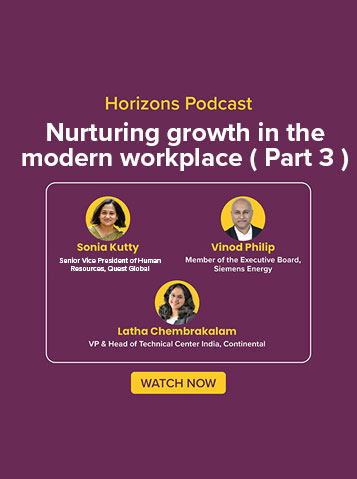
I recently met the senior vice president of one of our rail customers for dinner during a break in his board meeting. Within ten minutes, he’d cut to the chase and asked me: what is Quest Global doing to help solve supply chain problems internationally?
After our brief meeting, he would have to report on 100 million dollars in losses from supply chain issues to his board of directors. In such a high-stakes moment, he didn’t need to know the trends, and he didn’t want to discuss what the literature was saying on the topic. He wasn’t even trying to get an idea of solutions that were gaining traction in his industry—he wanted to know what Quest Global was doing to help our customers right now.
Rising to supply chain challenges in a VUCA world
The key post-pandemic takeaway in logistics management for organizations everywhere is that their strategy needs to prioritize being flexible, nimble, and resilient. This requires fresh thinking and a new breed of professionals across supply chain organizations who can think cross-vertically, finding creative ways to identify key logistics issues in industries that might not traditionally be factored into their organization’s strategy.
As a partner in SCM, Quest Global has access to a constant flow of rich data across key verticals that allows us to identify anomalous factors disrupting our clients’ supply networks. Our job is to accelerate the process of our clients’ SCM, keeping them ahead of the learning curve through a given crisis. We unite technologies and industries in a multi-dimensional approach that enables us to engage large-scale challenges across the Aerospace & Defense, Automotive, Energy, Hi-Tech, Healthcare, Medical Devices, Rail, and Semiconductor industries. We leverage this multi-dimensional positioning to maintain oversight of key quantitative data and a critical understanding of current industry trends and solutions.
Analysis paralysis: The need for a fresh perspective
Critical leaders, from board members to government officials, are identifying that anomalies in supply chains are becoming more normal. Management consultants are writing about it, and professionals in all industries are crafting economical solutions as governments directly engage in securing vital product networks. Still, our field continues to spiral as supply chains remain troubled.
Our field is increasingly populated by noise and clutter, and our analyses drive solutions that move us in circles. When we look beyond the oversaturation of approaches that are consistently coming short, we can identify that these fundamental supply chain issues stem from constraints and inefficiencies that have existed for multiple decades. These aren’t new issues, but the global shifts of the past two years have shaken our field to the point that we can no longer ignore these issues.
There are three areas businesses need to revisit:
1. Priorities: As a first step, supply chain organizations need to evolve their balanced scorecards.
2. Process and operations: Managers need to operationalize “lean concepts” to ensure that supply and demand are constantly in sync while value-detracting activities are eliminated. Rethinking technology platforms by leveraging “frugal tech” to eliminate inefficiencies is essential.
3. Organizational vitality: Our talent acquisition and development approaches need a refresh. Talent is the life essence of your organization and needs attention now. Traditional roles—from buyer to planner to logistics specialist—and their critical skills will need to be redefined, with product depth and technical savvy driving this evolution.
In supporting our customers as a supply chain partner, we operate as a generational partner to augment and accelerate transformations across those three areas. As companies scramble to rapidly transform their internal organization to adapt to the demands of the VUCA world, we enter as a strategic partner to drive the urgency and accelerate change management.
We catalyze transformation across a multitude of areas with various timelines to support our clients as they redesign their organizations’ strategies to: “manage the present,” “anticipate the near term,” and “plan for the future.” We align our solutions to our client’s product lifecycles to ensure we will calibrate your long-term market and customer needs effectively. We leverage our digital practice and strategic partnerships to offer pervasive technologies to disrupt and enhance these solutions. We support these solutions by establishing supply chain centres of excellence driven by mixed capability teams who provide best-in-class standard work and processes, digital technology partnerships, and fully managed service.
It takes a diamond to cut a diamond
Companies internationally have been faced with immense losses over the past two years, continuing to struggle with solutions as they analyze themselves into oblivion. After reporting on hundreds of millions in losses to the board, no number of McKinsey studies will solve a company’s supply chain problems. They need actionable strategies that factor in the bigger picture to address critical issues effectively. In many cases, this feels like an impenetrable barrier to growth in our VUCA reality. Quest Global is the partner that can facilitate changes to overcome those challenges. We are the most capable partner to address complex supply chain problems, not just now but generationally.
For example, industrial verticals like Aerospace and Defense maintain a long-term growth trajectory despite macroeconomic issues like inflated fuel costs and reduced capital expenditures from a potential recession. All verticals are highly vulnerable to geopolitical and economic instability & uncertainty. Within these industries, the geopolitical stances taken by governments, like sanctions and tariffs, have direct effects. This has a significant bearing on their logistics organizations.
During the last two decades, organizations like these have worked in a world driven by Volatility, Uncertainty, Chaos, and Ambiguity (VUCA). As economic cycles shrink, this is going to be the new norm. Where identifying key risk factors like inflation and recession might have once been enough to maintain a strategic hold of supply chain, senior leaders everywhere are struggling to determine why these practices no longer cut it.
By maintaining high-level oversight as a logistics partner with a diverse set of clients across multiple verticals, we’re positioned to identify factors contributing to the mass exodus of supply chain talent across the A&D tiers—a factor that has greatly exaggerated logistics challenges in these industries.










